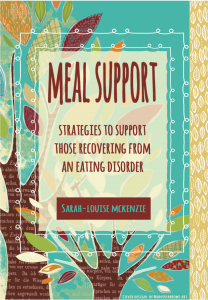 One of my dietitians in the Eating Disorders Unit at The Royal Brisbane and Women’s Hospital, Shane Jeffrey, provides a brilliant guide for nutrition and recovery. His acronym, RAVES, has directed my recovery when it comes to eating. He has generously given permission for me to share his work with you all.
One of my dietitians in the Eating Disorders Unit at The Royal Brisbane and Women’s Hospital, Shane Jeffrey, provides a brilliant guide for nutrition and recovery. His acronym, RAVES, has directed my recovery when it comes to eating. He has generously given permission for me to share his work with you all.
“The establishment of a regular, structured eating pattern that provides adequate nutrition is an important part of achieving nutritional rehabilitation and recovery from an eating disorder. However, for sustainability of recovery in the long term it is fundamental to develop a positive relationship with food. This involves the ability to eat a wider variety of foods, to eat in social situations, and to have flexibility in food choices incorporated into the eating plan. With this in mind, the process of RAVES (an acronym that highlights key aspects of nutritional recovery) provides a format and process of how to develop an eating pattern that helps support sustainable recovery.

It must be remembered that these five aspects of RAVES can’t be put in place all at once, and that the process of developing your eating pattern will take time, courage, trust and lots of ups and downs. However, by gradually developing your eating pattern using the principles of RAVES, you are laying the foundation for developing a more positive relationship with food. Remember, you can definitely take steps towards establishing a quality of life consistent with your individual values and a greater level of independence through improved nutrition.
 Regularity is the foundation of a structured eating pattern as it lays the base upon which the other aspects of having a positive relationship with food are built. A regular eating pattern will consist of eating every three hours or so, and includes three main meals and two to three snacks (Breakfast, Morning Tea, Lunch, Afternoon Tea, Dinner and Supper). Adopting and maintaining a regular eating pattern will assist in: providing structure to your daily routine; minimising grazing and preventing binging; improving your metabolism and your body’s ability to ‘burn’ food; strengthening your digestive muscles and improving bowel regularity; maintaining stable blood sugar levels throughout the day and evening; developing regular hunger and satiety signals that coincide with meal/snack times; and providing an opportunity to spread your nutrition through the day so that you are able to eat the amount of food necessary to meet your nutritional requirements. Once regularity has been established, the next nutritional goal is adequacy.
Regularity is the foundation of a structured eating pattern as it lays the base upon which the other aspects of having a positive relationship with food are built. A regular eating pattern will consist of eating every three hours or so, and includes three main meals and two to three snacks (Breakfast, Morning Tea, Lunch, Afternoon Tea, Dinner and Supper). Adopting and maintaining a regular eating pattern will assist in: providing structure to your daily routine; minimising grazing and preventing binging; improving your metabolism and your body’s ability to ‘burn’ food; strengthening your digestive muscles and improving bowel regularity; maintaining stable blood sugar levels throughout the day and evening; developing regular hunger and satiety signals that coincide with meal/snack times; and providing an opportunity to spread your nutrition through the day so that you are able to eat the amount of food necessary to meet your nutritional requirements. Once regularity has been established, the next nutritional goal is adequacy.
 Adequacy means getting enough food and nutrition to meet your nutritional requirements and achieve medical stabilisation, nutritional rehabilitation, and an appropriate goal weight range. Achieving nutritional adequacy consists of including all food groups in your eating pattern in a way that provides adequate protein, carbohydrate and fat to support nutritional balance and ongoing good nutrition. This will usually mean increasing the amount of food eaten across the three main meals and snacks, and will form the basis for long term weight maintenance and health in recovery.
Adequacy means getting enough food and nutrition to meet your nutritional requirements and achieve medical stabilisation, nutritional rehabilitation, and an appropriate goal weight range. Achieving nutritional adequacy consists of including all food groups in your eating pattern in a way that provides adequate protein, carbohydrate and fat to support nutritional balance and ongoing good nutrition. This will usually mean increasing the amount of food eaten across the three main meals and snacks, and will form the basis for long term weight maintenance and health in recovery.
 Variety is important because it plays an essential role in the development of a positive relationship with food and lays the foundation for more social eating. It is possible to reach your goal weight by eating the same foods each day, or by using nutritional supplements or nasogastric feeding, but the key to sustainability is in having a variety of food that you feel safe with. Having variety in the foods you eat makes food interesting, stimulates the taste buds, allows for eating opportunities with family and friends, and so really helps in the development of a positive relationship with food. Variety also helps challenge the notion of good and bad foods as it provides an opportunity for you to trust many different foods and is the stepping stone to further social eating opportunities with family and friends.
Variety is important because it plays an essential role in the development of a positive relationship with food and lays the foundation for more social eating. It is possible to reach your goal weight by eating the same foods each day, or by using nutritional supplements or nasogastric feeding, but the key to sustainability is in having a variety of food that you feel safe with. Having variety in the foods you eat makes food interesting, stimulates the taste buds, allows for eating opportunities with family and friends, and so really helps in the development of a positive relationship with food. Variety also helps challenge the notion of good and bad foods as it provides an opportunity for you to trust many different foods and is the stepping stone to further social eating opportunities with family and friends.
 Eating Socially and the ability to eat with others is an important part of working towards, and maintaining recovery. As the ability to eat in social situations develops further, opportunities exist to develop social networks that help distract from the eating disorder thoughts. This is because your mind is often more engaged in conversations with those around you rather than the eating disorder thoughts. Social eating is also an important part of recovery as it supports eating with family members, eating in the workplace or school, and eating with friends.
Eating Socially and the ability to eat with others is an important part of working towards, and maintaining recovery. As the ability to eat in social situations develops further, opportunities exist to develop social networks that help distract from the eating disorder thoughts. This is because your mind is often more engaged in conversations with those around you rather than the eating disorder thoughts. Social eating is also an important part of recovery as it supports eating with family members, eating in the workplace or school, and eating with friends.
 Spontaneity is important in nutritional recovery because it allows your relationship with food to be more natural. Spontaneity means eating foods that you have not planned for or doing things unexpectedly. For example, if you plan to have a specific meal and you get invited out for dinner, you can make the decision to go out for dinner even though that is not what was planned. What spontaneity brings to the eating pattern is a greater ability to be socially integrated from a food perspective and a greater ability to respond to unforeseen situations, which help in sustaining recovery for the long term.
Spontaneity is important in nutritional recovery because it allows your relationship with food to be more natural. Spontaneity means eating foods that you have not planned for or doing things unexpectedly. For example, if you plan to have a specific meal and you get invited out for dinner, you can make the decision to go out for dinner even though that is not what was planned. What spontaneity brings to the eating pattern is a greater ability to be socially integrated from a food perspective and a greater ability to respond to unforeseen situations, which help in sustaining recovery for the long term.
 Incorporating RAVES into my eating pattern was difficult to do without support, but the level of support I required did not exist outside of the hospital system, and those who wanted to support me, were unsure of how to do so. After much trial and error, research, and collaboration, I wrote “Meal support: strategies to support those recovering from an eating disorder”. I really encourage you to get a copy of this and read it through (and also have those who you would like to support you read it!!!). It is easy to read and designed in such a way that you can identify your goals and that which would support you, as I recognise that when it comes to support and recovery, one size does not fit all.
Incorporating RAVES into my eating pattern was difficult to do without support, but the level of support I required did not exist outside of the hospital system, and those who wanted to support me, were unsure of how to do so. After much trial and error, research, and collaboration, I wrote “Meal support: strategies to support those recovering from an eating disorder”. I really encourage you to get a copy of this and read it through (and also have those who you would like to support you read it!!!). It is easy to read and designed in such a way that you can identify your goals and that which would support you, as I recognise that when it comes to support and recovery, one size does not fit all.